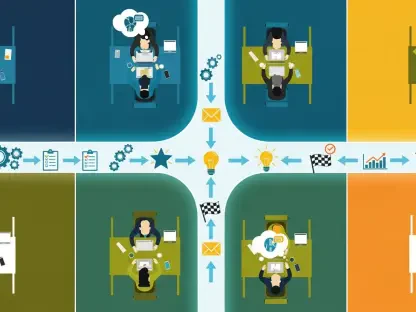In today’s rapidly evolving professional landscape, the emphasis on workplace culture has surged to the forefront as companies strive to nurture environments where employees feel they genuinely belong. This concept of belonging is fundamental to human nature, serving as a critical component that not only impacts individual well-being but also fuels the overall success of an organization. The modern workplace is tasked with building a culture that values and supports its workforce, thus promoting mental health and heightening employee engagement, which in turn yields economic and cultural benefits. As organizations continue to adapt to these demands, the synergy between belonging and workplace culture has become an essential focal point, reshaping traditional perceptions and paving the way for transformative change.
Evolution of Workplace Structures
Historical Context and Modern Dynamics
Throughout the history of labor, workplace structures have undergone a significant transformation, particularly evident with the introduction of the standard 40-hour workweek, labor unions, and minimum wage laws. These developments marked a shift in how individuals perceived their jobs, viewing them not only as a means of economic stability but also as communities where emotional needs could be met. As this perception took root, workplaces became central to one’s identity and social connections, fostering a sense of belonging that was both desired and necessary.
In contemporary settings, however, a disconnect often persists between the fulfillment that companies promise and employees’ actual experiences. Many workers find themselves disenchanted with their current roles, driven by motivations beyond just salary, such as engagement, work-life balance, and corporate culture. This disparity is vividly depicted in reports like those from Gallup, where a significant portion of employees consider leaving their jobs if presented with better opportunities, prioritizing factors like engagement and cultural fit over purely monetary incentives. The challenge for modern companies is not only to recognize this shift in priorities but to actively cultivate an environment where belonging is ingrained in the workplace ethos.
Discontent and Its Impact
The ramifications of workplace discontent extend far beyond individual dissatisfaction, with organizational productivity and economic performance bearing the brunt. Disengagement among employees has proven costly, with lost productivity amounting to staggering financial figures. Such discontent arises primarily from a lack of genuine connection and recognition within the work environment, where employees feel undervalued and personally disconnected from their roles.
In examining the underlying causes of disengagement, various factors contribute to a sense of isolation and detachment. Workplace trauma, including experiences of bullying, gaslighting, and unrealistic expectations, exacerbates these feelings, leaving employees demoralized and distressed. The American Psychological Association’s findings highlight the prevalence of such negative experiences, revealing the considerable impact on employees’ mental health. Addressing these issues necessitates a proactive approach by organizations, one that acknowledges the historical context and adapts to contemporary dynamics to foster a truly supportive and inclusive culture.
Addressing Workplace Trauma
The Role of Social Rhythms
A fundamental aspect contributing to workplace trauma is the existence of “social rhythms,” a term used to describe the unconscious patterns of behavior that lead to exclusion. These rhythms manifest when leaders or coworkers engage in non-inclusive practices, either through overt dismissal or through subtler means such as quick decision-making that bypasses diverse input. The systemic nature of these behaviors requires leaders to cultivate an acute awareness of their influence on workplace dynamics, encouraging shifts in behavior that foster inclusion.
Fostering inclusion extends beyond simple policy changes and requires a comprehensive approach to understanding and modifying social rhythms. Leaders and influencers within organizations are tasked with the responsibility of cultivating an environment where diverse opinions are not only considered but valued as integral to the decision-making process. Transitioning from exclusionary practices to inclusive engagement demands a reevaluation of inherent biases, alongside a commitment to embracing diverse perspectives as a means to enrich workplace culture.
Building an Inclusive Environment
Creating an inclusive environment where employees feel psychologically safe is critical in mitigating trauma and sustaining engagement. Psychological safety, defined as an atmosphere where individuals feel secure in sharing ideas and expressing concerns without fear of reprisal, constitutes the cornerstone of modern workplace safety. This sense of safety enables employees to take calculated risks, voice their opinions, and contribute meaningfully to organizational progress.
Organizations striving to build such an environment must rely on introspection and continuous feedback. By emphasizing 360-degree feedback reviews, companies can encourage open dialogue, fostering trust and respect within teams. Regular reviews allow leaders to better understand the perspectives of employees, identify lapses in inclusion, and tailor strategies that ensure all employees feel both appreciated and heard. These practices not only bolster individual confidence but also enhance collective growth by harnessing the diverse strengths of the workforce.
Psychological Safety and Economic Benefits
Embracing Diversity and Innovation
The intentional establishment of a safe and supportive work environment proves instrumental in unlocking innovation and creativity, driving economic advantages across industries. By ensuring that every employee feels comfortable and valued, organizations can effectively tap into the collective potential of their workforce. The interplay between diversity and innovation becomes apparent when employees from varied backgrounds collaborate seamlessly, each contributing unique insights and ideas that propel creative solutions.
Equally important is the recognition that unequal treatment of groups within an organization can severely curtail productivity and increase turnover rates. Economic analyses reveal that discriminatory practices lead to substantial financial losses, underscoring the need for organizations to actively dismantle barriers that hinder inclusivity. Forward-thinking leaders understand that the path to sustained innovation lies in acknowledging and celebrating the diversity of their teams, knowing that diverse voices yield richer, more comprehensive problem-solving approaches.
Harnessing Employee Potential
Realizing the full potential of employees necessitates more than an acknowledgment of their contributions; it requires a commitment to cultivating an environment where every person can thrive. Psychological safety plays a pivotal role in this, as it encourages employees to leverage their talents without constraints, helping organizations maximize their resources. This empowerment not only enhances job satisfaction but also drives tangible economic benefits by reducing turnover rates and fostering loyalty.
For companies, the intersection of belonging and innovation presents a profound opportunity to gain a competitive edge. By cultivating a culture that prioritizes safety and inclusion, organizations can attract and retain top talent, translating these advantages into market success. Those that effectively harness this potential demonstrate resilience and adaptability, critical traits in an increasingly competitive and dynamic business environment.
Individual Empowerment and Identity
Navigating Belonging on a Personal Level
While workplaces have a significant role in fostering opportunities for belonging, the state of belonging ultimately hinges on individual choices. Employees are encouraged to navigate their sense of belonging through the authentic expression of themselves, establishing boundaries, and communicating needs effectively within the organizational framework. Such personal initiatives help mitigate identity dysmorphia, a condition where individuals conflate their self-worth with workplace validation, thereby achieving a more balanced personal and professional identity.
Individual empowerment involves self-awareness and a commitment to bringing one’s true self to work, facilitating genuine connections with colleagues who align with personal values. This approach not only strengthens one’s sense of belonging but also enriches the organizational culture by contributing diverse perspectives and fostering a more inclusive environment. As employees embrace their authenticity, they actively contribute to a collective culture that values individuality while promoting shared goals.
Balancing Work and Personal Identity
Beyond professional environments, individuals must cultivate identities that transcend their roles within the workplace. Historical trends have often seen employees sacrificing personal values for corporate missions, but recent shifts, propelled by the COVID-19 pandemic, highlight a reevaluation of work-life priorities. The result is a growing demand for organizations that emphasize well-being and support holistic employee development, aligning with the evolving expectations of a diverse workforce.
Achieving this balance requires a thoughtful and strategic approach that empowers employees to pursue meaningful engagements beyond work, fostering a well-rounded identity that reflects both their personal and professional aspirations. This alignment encourages individuals to seek opportunities for growth and engagement, not only within their job roles but also in broader life pursuits. Organizations that successfully accommodate this shift benefit from motivated employees who value their contributions and invest wholeheartedly in achieving shared objectives.
Fostering Transformative Change
Prioritizing Human Capital
The transformative power of cultivating belonging within workplace culture lies in its ability to impact both employee and organizational advancement. Central to this transformation is the recognition of human resources as the most valuable and essential component of organizational success. When companies prioritize the management of their human portfolio, they acknowledge employees as strategic assets whose contributions drive innovation and growth.
Despite its substantial impact, human resource management is often underestimated, relegated to the status of a “soft skill” rather than a core function of leadership and strategic planning. Forward-thinking organizations that embrace this shift view the nurturing of workplace culture as an integral element of their success, emphasizing employee development and engagement as crucial components of business strategies. Aligning policies and practices with these priorities ensures sustainable growth and competitiveness within the market.
Continuous Evolution and Reflection
Over time, workplace structures have undergone major shifts. The implementation of the 40-hour workweek, labor unions, and minimum wage laws marked a pivotal change in how individuals viewed their jobs. These advancements transformed jobs from mere economic support systems to communities where emotional needs could be satisfied. Consequently, workplaces evolved into hubs for identity and social bonds, fostering a sense of belonging.
Today, however, there’s often a gap between the promised fulfillment from companies and employees’ experiences. Disillusionment is common among workers, who are motivated by factors that surpass salary, such as engagement, work-life balance, and work culture. Reports like Gallup illustrate that many employees would leave for better opportunities, favoring engagement and cultural fit over financial incentives. Modern companies face the challenge of acknowledging these shifts and nurturing an environment where a sense of belonging is embedded in workplace culture, making it central to employee satisfaction and retention.









